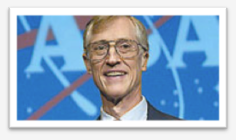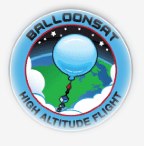This is anexclusive invitation just for participating NASA Explorer Schools high schoolteachers.

Are your students boggled by the big bang theory? Are they captivated by cosmic background radiation? Are they fascinated by the formation of planets, stars and galaxies? Then May’s NES online video chat is their chance to have their questions answered. Dr. John C. Mather, Senior Project Scientist for the James Webb Space Telescope and 2006 Nobel Prize winner in physics for his work on the big bang theory, will be answering student questions during a live video chat.
Thehour-long chat will be on Tuesday, May 17, beginning at 1:30 p.m. EDT.
Teachersare invited to send up to 10 student questions to Mather through either digitalvideo or email. Video questions will be given priority.
Submitting a Question (The deadlinefor submitting questions is May 1):
Allquestions must include:
- The student’s FIRST NAME only
- Grade/subject
- School name
- The question
For example, “My name is Sara and I’m a 10th-grade astronomystudent at Johnson High School. My question is…”
- Request a blank media release form from nasa-explorer-schools@mail.nasa.gov. A completed NES media release form must be submitted for each student featured in a video. Media release forms must be faxed to 216-433-5924 or scanned and sent to nasa-explorer-schools@mail.nasa.gov with the subject “Media Release for Dr. Mather Chat.”
- One student question per file and 10 questions per teacher may be submitted.
- To improve the chances of your video being selected, review the “Camera Techniques” list at the bottom of this message.
- All submitted video files will be destroyed at the conclusion of the video chat. Questions asked during the chat will be part of the video archive, which will be available on the NES Virtual Campus website.
Email questions: Student questions may be sent bythe teacher to nasa-explorer-schools@mail.nasa.gov, with the subject, “Dr.Mather Chat.” Teachers may submit up to 10 student questions as text in thebody of a single email and only one email per teacher can be accepted.
Onlyquestions following these guidelines will be considered. Selected questionswill be included in the May 17 chat with Dr. Mather.
Watchthe video chat at on the Virtual Campus.
Camera Techniques for StudentQuestions:
- Be sure your camera is set to the highest quality video settings.
- Position the camera on a tripod at eye level with the student.
- Only the student asking the question should be seen in the video.
- Record in a well-lit area, with no bright lights or windows visible in the picture behind the student.
- The student should be at least six feet from a wall or background.
- The student should be no more than four feet from the camera.
- Frame the student from waist up or mid-chest up.
- Record in an area free from loud noises or HVAC units.
- If possible, for best audio quality, use an external hand-held or lavaliere microphone.
- When recording, make sure the student speaks clearly in a full voice and doesn’t rush through the question.
- Contact nasa-explorer-schools@mail.nasa.gov for uploading instructions.
Link to the NES Virtual Campus home page.

 Applications for membership to the 2011 – 2012 INSPIRE Online Learning Community, or OLC, are now being accepted. The deadline for applying is
Applications for membership to the 2011 – 2012 INSPIRE Online Learning Community, or OLC, are now being accepted. The deadline for applying is  In this installment of NASA Now, you’ll meet Guidance, Navigation and Flight Controls engineer George Hatcher, who talks about the complex system needed to fly the space shuttle at extreme speeds and in extreme environments. Learn about the instruments used to inform the shuttle of its location, how to get where it wants to go, and what to do to change direction. The program focuses on the technology and physics of this complex spacecraft.
In this installment of NASA Now, you’ll meet Guidance, Navigation and Flight Controls engineer George Hatcher, who talks about the complex system needed to fly the space shuttle at extreme speeds and in extreme environments. Learn about the instruments used to inform the shuttle of its location, how to get where it wants to go, and what to do to change direction. The program focuses on the technology and physics of this complex spacecraft.
 On Feb. 8, from 11:15 a.m. to 12:15 p.m. EST, a special Digital Learning Network event with astronaut Ron Garan will be held. Garan is scheduled to launch to the International Space Station in March of this year. During the special webcast event, Garan will discuss his upcoming mission and answer questions from students. Students across the country will be able to watch the DLiNfo Channel’s webcast, and they will be able to e-mail their questions for Garan to answer during the program.
On Feb. 8, from 11:15 a.m. to 12:15 p.m. EST, a special Digital Learning Network event with astronaut Ron Garan will be held. Garan is scheduled to launch to the International Space Station in March of this year. During the special webcast event, Garan will discuss his upcoming mission and answer questions from students. Students across the country will be able to watch the DLiNfo Channel’s webcast, and they will be able to e-mail their questions for Garan to answer during the program. Check out part 2 of the NASA Now: A-Train series and learn how NASA uses a constellation of satellites called the A-Train to monitor the Earth system. Five NASA satellites comprise the A-Train. They fly over the same location on Earth within 15 minutes of each other collecting data about the current state of the components of the Earth system.
Check out part 2 of the NASA Now: A-Train series and learn how NASA uses a constellation of satellites called the A-Train to monitor the Earth system. Five NASA satellites comprise the A-Train. They fly over the same location on Earth within 15 minutes of each other collecting data about the current state of the components of the Earth system. During this installment of NASA Now, NASA senior research engineer Judith Watson describes the project she’s currently working on. She’s one of a team of engineers at NASA’s Langley Research Center who are studying inflatable structures that might one day be used to establish an outpost on the moon or Mars.
During this installment of NASA Now, NASA senior research engineer Judith Watson describes the project she’s currently working on. She’s one of a team of engineers at NASA’s Langley Research Center who are studying inflatable structures that might one day be used to establish an outpost on the moon or Mars.